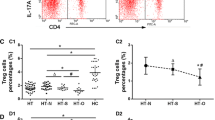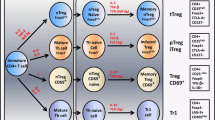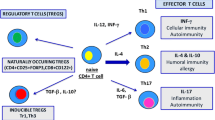Abstract
Purpose
Graves’ disease (GD) is an autoimmune thyroid disease, and the most important characteristic of it is the presence of the thyroid-stimulating antibody (TSAb). The mechanisms of the TSAb elevation are still uncertain. Recent studies have suggested that the dysregulation of regulatory T cell (Treg) and T helper 17 (Th17) might stimulate the production of TSAb and be a pathogenesis of GD. However, the role of Treg and Th17 cells in the pathogenesis of GD is still debated. Our aim is to assess changes of Treg and Th17 cells in the spleen of a mouse in an in vivo GD model and try to explain the pathogenesis of GD.
Methods
We used an adenovirus expressing the autoantigen thyroid-stimulating hormone receptor (Ad-TSHR289) to immunise mice in order to induce GD in the model. Flow cytometry was used to measure the frequencies of splenic Treg and Th17 cells and real-time PCR to analyse the mRNA expression of forkhead box P3(Foxp3) and interleukin-17(IL-17).
Results
Compared with the Ad-Control group, the frequencies of CD4+CD25+Foxp3+ Treg cells were significantly decreased (p = 0.007) and gene expression of Foxp3 was down-regulated (p = 0.001) in the Ad-TSHR289 group. Though there was no significant difference in CD4+IL-17+ T cell subpopulation between the two groups (p = 0.336), the IL-17 mRNA expression was significantly up-regulated in the Ad-TSHR289 group (p = 0.001).
Conclusions
The pathogenesis of GD may be associated with reduced Treg cells and increased IL-17 gene expression. The increased IL-17 mRNA needs to be explained by other mechanisms but not Th17 cells.





Similar content being viewed by others
References
Cooper GS, Stroehla BC (2003) The epidemiology of autoimmune diseases. Autoimmun Rev 2(3):119–125
Bahn RS, Burch HB, Cooper DS, Garber JR, Greenlee MC, Klein I, Laurberg P, McDougall IR, Montori VM, Rivkees SA, Ross DS, Sosa JA, Stan MN (2011) Hyperthyroidism and other causes of thyrotoxicosis: management guidelines of the American Thyroid Association and American Association of Clinical Endocrinologists. Endocr Pract 17(3):456–520
Zhang K, Lin Y, Fang Z, Luo C, Liu X, Zhang F, Chen G, Wensheng WU (2002) The effect of salt iodization for 10 years on the prevalences of endemic goiter and hyperthyroidism. Chin J Endocrinol Metab (5):12–14
Hollowell JG, Staehling NW, Flanders WD, Hannon WH, Gunter EW, Spencer CA, Braverman LE (2002) Serum TSH, T(4), and thyroid antibodies in the United States population (1988 to 1994): National Health and Nutrition Examination Survey (NHANES III). J Clin Endocrinol Metab 87(2):489–499. doi:10.1210/jcem.87.2.8182
DeGroot LJ (2000) Graves’ Disease and the Manifestations of Thyrotoxicosis. In: De Groot LJ, Beck-Peccoz P, Chrousos G et al (eds) Endotext. MDText.com Inc, South Dartmouth
Marino M, Latrofa F, Menconi F, Chiovato L, Vitti P (2015) Role of genetic and non-genetic factors in the etiology of Graves’ disease. J Endocrinol Invest 38(3):283–294. doi:10.1007/s40618-014-0214-2
Marino M, Latrofa F, Menconi F, Chiovato L, Vitti P (2014) An update on the medical treatment of Graves’ hyperthyroidism. J Endocrinol Invest 37(11):1041–1048. doi:10.1007/s40618-014-0136-z
Bartalena L, Chiovato L, Vitti P (2016) Management of hyperthyroidism due to Graves’ disease: frequently asked questions and answers (if any). J Endocrinol Invest. doi:10.1007/s40618-016-0505-x
Morshed SA, Latif R, Davies TF (2012) Delineating the autoimmune mechanisms in Graves’ disease. Immunol Res 54(1–3):191–203. doi:10.1007/s12026-012-8312-8
Kampmann E, Diana T, Kanitz M, Hoppe D, Kahaly GJ (2015) Thyroid stimulating but not blocking autoantibodies are highly prevalent in severe and active thyroid-associated orbitopathy: a prospective study. Int J Endocrinol 2015:678194. doi:10.1155/2015/678194
Diana T, Brown RS, Bossowski A, Segni M, Niedziela M, Konig J, Bossowska A, Ziora K, Hale A, Smith J, Pitz S, Kanitz M, Kahaly GJ (2014) Clinical relevance of thyroid-stimulating autoantibodies in pediatric graves’ disease-a multicenter study. J Clin Endocrinol Metab 99(5):1648–1655. doi:10.1210/jc.2013-4026
Weetman AP, Yateman ME, Ealey PA, Black CM, Reimer CB, Williams RC Jr, Shine B, Marshall NJ (1990) Thyroid-stimulating antibody activity between different immunoglobulin G subclasses. J Clin Invest 86(3):723–727. doi:10.1172/jci114768
McLachlan SM, Nagayama Y, Rapoport B (2005) Insight into Graves’ hyperthyroidism from animal models. Endocr Rev 26(6):800–832. doi:10.1210/er.2004-0023
Nagayama Y (2007) Graves’ animal models of Graves’ hyperthyroidism. Thyroid 17(10):981–988. doi:10.1089/thy.2007.0161
Zuniga LA, Jain R, Haines C, Cua DJ (2013) Th17 cell development: from the cradle to the grave. Immunol Rev 252(1):78–88. doi:10.1111/imr.12036
Grant CR, Liberal R, Mieli-Vergani G, Vergani D, Longhi MS (2015) Regulatory T-cells in autoimmune diseases: challenges, controversies and–yet–unanswered questions. Autoimmun Rev 14(2):105–116. doi:10.1016/j.autrev.2014.10.012
Infante-Duarte C, Horton HF, Byrne MC, Kamradt T (2000) Microbial lipopeptides induce the production of IL-17 in Th cells. J Immunol 165(11):6107–6115
Hundorfean G, Neurath MF, Mudter J (2012) Functional relevance of T helper 17 (Th17) cells and the IL-17 cytokine family in inflammatory bowel disease. Inflamm Bowel Dis 18(1):180–186. doi:10.1002/ibd.21677
Nakae S, Nambu A, Sudo K, Iwakura Y (2003) Suppression of immune induction of collagen-induced arthritis in IL-17-deficient mice. J Immunol 171(11):6173–6177
Steinman L (2005) Blocking adhesion molecules as therapy for multiple sclerosis: natalizumab. Nat Rev Drug Discov 4(6):510–518. doi:10.1038/nrd1752
Hsu HC, Yang P, Wang J, Wu Q, Myers R, Chen J, Yi J, Guentert T, Tousson A, Stanus AL, Le TV, Lorenz RG, Xu H, Kolls JK, Carter RH, Chaplin DD, Williams RW, Mountz JD (2008) Interleukin 17-producing T helper cells and interleukin 17 orchestrate autoreactive germinal center development in autoimmune BXD2 mice. Nat Immunol 9(2):166–175. doi:10.1038/ni1552
Bedoya SK, Lam B, Lau K, Larkin J 3rd (2013) Th17 cells in immunity and autoimmunity. Clin Dev Immunol 2013:986789. doi:10.1155/2013/986789
Nanba T, Watanabe M, Inoue N, Iwatani Y (2009) Increases of the Th1/Th2 cell ratio in severe Hashimoto’s disease and in the proportion of Th17 cells in intractable Graves’ disease. Thyroid 19(5):495–501. doi:10.1089/thy.2008.0423
von Spee-Mayer C, Siegert E, Abdirama D, Rose A, Klaus A, Alexander T, Enghard P, Sawitzki B, Hiepe F, Radbruch A, Burmester GR, Riemekasten G, Humrich JY (2015) Low-dose interleukin-2 selectively corrects regulatory T cell defects in patients with systemic lupus erythematosus. Ann Rheum Dis. doi:10.1136/annrheumdis-2015-207776
Chen CR, Pichurin P, Chazenbalk GD, Aliesky H, Nagayama Y, McLachlan SM, Rapoport B (2004) Low-dose immunization with adenovirus expressing the thyroid-stimulating hormone receptor A-subunit deviates the antibody response toward that of autoantibodies in human Graves’ disease. Endocrinology 145(1):228–233. doi:10.1210/en.2003-1134
Roncarolo MG, Gregori S, Bacchetta R, Battaglia M (2014) Tr1 cells and the counter-regulation of immunity: natural mechanisms and therapeutic applications. Curr Top Microbiol Immunol 380:39–68. doi:10.1007/978-3-662-43492-5_3
Marazuela M, Garcia-Lopez MA, Figueroa-Vega N, de la Fuente H, Alvarado-Sanchez B, Monsivais-Urenda A, Sanchez-Madrid F, Gonzalez-Amaro R (2006) Regulatory T cells in human autoimmune thyroid disease. J Clin Endocrinol Metab 91(9):3639–3646. doi:10.1210/jc.2005-2337
Sakaguchi S (2005) Naturally arising Foxp3-expressing CD25 + CD4 + regulatory T cells in immunological tolerance to self and non-self. Nat Immunol 6(4):345–352. doi:10.1038/ni1178
Bossowski A, Moniuszko M, Dabrowska M, Sawicka B, Rusak M, Jeznach M, Wojtowicz J, Bodzenta-Lukaszyk A, Bossowska A (2013) Lower proportions of CD4 + CD25(high) and CD4 + FoxP3, but not CD4 + CD25 + CD127(low) FoxP3 + T cell levels in children with autoimmune thyroid diseases. Autoimmunity 46(3):222–230. doi:10.3109/08916934.2012.751981
Mao C, Wang S, Xiao Y, Xu J, Jiang Q, Jin M, Jiang X, Guo H, Ning G, Zhang Y (2011) Impairment of regulatory capacity of CD4 + CD25 + regulatory T cells mediated by dendritic cell polarization and hyperthyroidism in Graves’ disease. J Immunol 186(8):4734–4743. doi:10.4049/jimmunol.0904135
Saitoh O, Nagayama Y (2006) Regulation of Graves’ hyperthyroidism with naturally occurring CD4 + CD25 + regulatory T cells in a mouse model. Endocrinology 147(5):2417–2422. doi:10.1210/en.2005-1024
Qureshi OS, Zheng Y, Nakamura K, Attridge K, Manzotti C, Schmidt EM, Baker J, Jeffery LE, Kaur S, Briggs Z, Hou TZ, Futter CE, Anderson G, Walker LS, Sansom DM (2011) Trans-endocytosis of CD80 and CD86: a molecular basis for the cell-extrinsic function of CTLA-4. Science 332(6029):600–603. doi:10.1126/science.1202947
Cao X, Cai SF, Fehniger TA, Song J, Collins LI, Piwnica-Worms DR, Ley TJ (2007) Granzyme B and perforin are important for regulatory T cell-mediated suppression of tumor clearance. Immunity 27(4):635–646. doi:10.1016/j.immuni.2007.08.014
Fahlen L, Read S, Gorelik L, Hurst SD, Coffman RL, Flavell RA, Powrie F (2005) T cells that cannot respond to TGF-beta escape control by CD4(+)CD25(+) regulatory T cells. J Exp Med 201(5):737–746. doi:10.1084/jem.20040685
Hara M, Kingsley CI, Niimi M, Read S, Turvey SE, Bushell AR, Morris PJ, Powrie F, Wood KJ (2001) IL-10 is required for regulatory T cells to mediate tolerance to alloantigens in vivo. J Immunol 166(6):3789–3796
Collison LW, Workman CJ, Kuo TT, Boyd K, Wang Y, Vignali KM, Cross R, Sehy D, Blumberg RS, Vignali DA (2007) The inhibitory cytokine IL-35 contributes to regulatory T-cell function. Nature 450(7169):566–569. doi:10.1038/nature06306
Deaglio S, Dwyer KM, Gao W, Friedman D, Usheva A, Erat A, Chen JF, Enjyoji K, Linden J, Oukka M, Kuchroo VK, Strom TB, Robson SC (2007) Adenosine generation catalyzed by CD39 and CD73 expressed on regulatory T cells mediates immune suppression. J Exp Med 204(6):1257–1265. doi:10.1084/jem.20062512
Song X, Gao H, Qian Y (2014) Th17 differentiation and their pro-inflammation function. Adv Exp Med Biol 841:99–151. doi:10.1007/978-94-017-9487-9_5
Ghoreschi K, Laurence A, Yang XP, Tato CM, McGeachy MJ, Konkel JE, Ramos HL, Wei L, Davidson TS, Bouladoux N, Grainger JR, Chen Q, Kanno Y, Watford WT, Sun HW, Eberl G, Shevach EM, Belkaid Y, Cua DJ, Chen W, O’Shea JJ (2010) Generation of pathogenic T(H)17 cells in the absence of TGF-beta signalling. Nature 467(7318):967–971. doi:10.1038/nature09447
Langrish CL, Chen Y, Blumenschein WM, Mattson J, Basham B, Sedgwick JD, McClanahan T, Kastelein RA, Cua DJ (2005) IL-23 drives a pathogenic T cell population that induces autoimmune inflammation. J Exp Med 201(2):233–240. doi:10.1084/jem.20041257
Ghoreschi K, Laurence A, Yang XP, Hirahara K, O’Shea JJ (2011) T helper 17 cell heterogeneity and pathogenicity in autoimmune disease. Trends Immunol 32(9):395–401. doi:10.1016/j.it.2011.06.007
Lee Y, Awasthi A, Yosef N, Quintana FJ, Xiao S, Peters A, Wu C, Kleinewietfeld M, Kunder S, Hafler DA, Sobel RA, Regev A, Kuchroo VK (2012) Induction and molecular signature of pathogenic TH17 cells. Nat Immunol 13(10):991–999. doi:10.1038/ni.2416
Basdeo SA, Moran B, Cluxton D, Canavan M, McCormick J, Connolly M, Orr C, Mills KH, Veale DJ, Fearon U, Fletcher JM (2015) Polyfunctional, pathogenic CD161 + Th17 lineage cells are resistant to regulatory T cell-mediated suppression in the context of autoimmunity. J Immunol 195(2):528–540. doi:10.4049/jimmunol.1402990
Zhou J, Bi M, Fan C, Song X, Yang R, Zhao S, Li L, Li Y, Teng W, Shan Z (2012) Regulatory T cells but not T helper 17 cells are modulated in an animal model of Graves’ hyperthyroidism. Clin Exp Med 12(1):39–46. doi:10.1007/s10238-011-0137-6
Komiyama Y, Nakae S, Matsuki T, Nambu A, Ishigame H, Kakuta S, Sudo K, Iwakura Y (2006) IL-17 plays an important role in the development of experimental autoimmune encephalomyelitis. J Immunol 177(1):566–573
Lubberts E, Joosten LA, Oppers B, van den Bersselaar L, Coenen-de Roo CJ, Kolls JK, Schwarzenberger P, van de Loo FA, van den Berg WB (2001) IL-1-independent role of IL-17 in synovial inflammation and joint destruction during collagen-induced arthritis. J Immunol 167(2):1004–1013
Kim SE, Yoon JS, Kim KH, Lee SY (2012) Increased serum interleukin-17 in Graves’ ophthalmopathy. Graefes Arch Clin Exp Ophthalmol 250(10):1521–1526. doi:10.1007/s00417-012-2092-7
Zheng L, Ye P, Liu C (2013) The role of the IL-23/IL-17 axis in the pathogenesis of Graves’ disease. Endocr J 60(5):591–597
Xu S, Cao X (2010) Interleukin-17 and its expanding biological functions. Cell Mol Immunol 7(3):164–174. doi:10.1038/cmi.2010.21
Happel KI, Zheng M, Young E, Quinton LJ, Lockhart E, Ramsay AJ, Shellito JE, Schurr JR, Bagby GJ, Nelson S, Kolls JK (2003) Cutting edge: roles of Toll-like receptor 4 and IL-23 in IL-17 expression in response to Klebsiella pneumoniae infection. J Immunol 170(9):4432–4436
Rachitskaya AV, Hansen AM, Horai R, Li Z, Villasmil R, Luger D, Nussenblatt RB, Caspi RR (2008) Cutting edge: NKT cells constitutively express IL-23 receptor and RORgammat and rapidly produce IL-17 upon receptor ligation in an IL-6-independent fashion. J Immunol 180(8):5167–5171
Sutton CE, Lalor SJ, Sweeney CM, Brereton CF, Lavelle EC, Mills KH (2009) Interleukin-1 and IL-23 induce innate IL-17 production from gammadelta T cells, amplifying Th17 responses and autoimmunity. Immunity 31(2):331–341. doi:10.1016/j.immuni.2009.08.001
Lochner M, Peduto L, Cherrier M, Sawa S, Langa F, Varona R, Riethmacher D, Si-Tahar M, Di Santo JP, Eberl G (2008) In vivo equilibrium of proinflammatory IL-17 + and regulatory IL-10 + Foxp3 + RORgamma t + T cells. J Exp Med 205(6):1381–1393. doi:10.1084/jem.20080034
Lee YK, Mukasa R, Hatton RD, Weaver CT (2009) Developmental plasticity of Th17 and Treg cells. Curr Opin Immunol 21(3):274–280. doi:10.1016/j.coi.2009.05.021
Acknowledgements
We thank Basil Rapoport (University of California-Los Angeles) for providing us with the plasmid of pSV2neoECE-TSHR289-6H-dhfr. We also thank National Natural Science Foundation of China for its generous support (Grant No. 81373593) without which our work would not have been possible.
Author information
Authors and Affiliations
Corresponding author
Ethics declarations
Conflict of interest
The authors declare that they have no conflict of interest.
Ethical approval
All procedures performed in studies involving animals were in accordance with the ethical standards of the institution or practice at which the studies were conducted.
Informed consent
No informed consent.
Rights and permissions
About this article
Cite this article
Yuan, Q., Zhao, Y., Zhu, X. et al. Low regulatory T cell and high IL-17 mRNA expression in a mouse Graves’ disease model. J Endocrinol Invest 40, 397–407 (2017). https://doi.org/10.1007/s40618-016-0575-9
Received:
Accepted:
Published:
Issue Date:
DOI: https://doi.org/10.1007/s40618-016-0575-9




